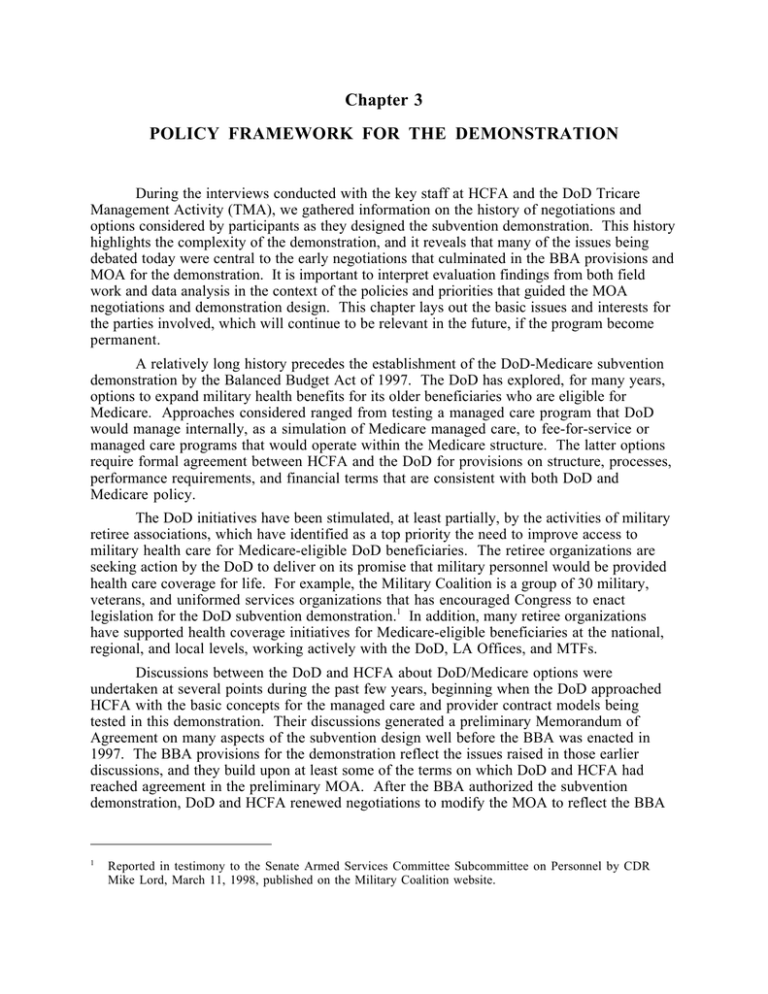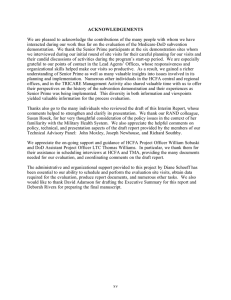Chapter 3 POLICY FRAMEWORK FOR THE DEMONSTRATION
advertisement

Chapter 3 POLICY FRAMEWORK FOR THE DEMONSTRATION During the interviews conducted with the key staff at HCFA and the DoD Tricare Management Activity (TMA), we gathered information on the history of negotiations and options considered by participants as they designed the subvention demonstration. This history highlights the complexity of the demonstration, and it reveals that many of the issues being debated today were central to the early negotiations that culminated in the BBA provisions and MOA for the demonstration. It is important to interpret evaluation findings from both field work and data analysis in the context of the policies and priorities that guided the MOA negotiations and demonstration design. This chapter lays out the basic issues and interests for the parties involved, which will continue to be relevant in the future, if the program become permanent. A relatively long history precedes the establishment of the DoD-Medicare subvention demonstration by the Balanced Budget Act of 1997. The DoD has explored, for many years, options to expand military health benefits for its older beneficiaries who are eligible for Medicare. Approaches considered ranged from testing a managed care program that DoD would manage internally, as a simulation of Medicare managed care, to fee-for-service or managed care programs that would operate within the Medicare structure. The latter options require formal agreement between HCFA and the DoD for provisions on structure, processes, performance requirements, and financial terms that are consistent with both DoD and Medicare policy. The DoD initiatives have been stimulated, at least partially, by the activities of military retiree associations, which have identified as a top priority the need to improve access to military health care for Medicare-eligible DoD beneficiaries. The retiree organizations are seeking action by the DoD to deliver on its promise that military personnel would be provided health care coverage for life. For example, the Military Coalition is a group of 30 military, veterans, and uniformed services organizations that has encouraged Congress to enact legislation for the DoD subvention demonstration.1 In addition, many retiree organizations have supported health coverage initiatives for Medicare-eligible beneficiaries at the national, regional, and local levels, working actively with the DoD, LA Offices, and MTFs. Discussions between the DoD and HCFA about DoD/Medicare options were undertaken at several points during the past few years, beginning when the DoD approached HCFA with the basic concepts for the managed care and provider contract models being tested in this demonstration. Their discussions generated a preliminary Memorandum of Agreement on many aspects of the subvention design well before the BBA was enacted in 1997. The BBA provisions for the demonstration reflect the issues raised in those earlier discussions, and they build upon at least some of the terms on which DoD and HCFA had reached agreement in the preliminary MOA. After the BBA authorized the subvention demonstration, DoD and HCFA renewed negotiations to modify the MOA to reflect the BBA 1 Reported in testimony to the Senate Armed Services Committee Subcommittee on Personnel by CDR Mike Lord, March 11, 1998, published on the Military Coalition website. requirements and to finalize the ground rules for the design, implementation, and evaluation of the demonstration. The establishment of a mechanism for financial subvention-the transfer of funds from HCFA to DoD-creates opposing financial interests for these two government bodies, even as they share commitments to provide access to quality health care services for their beneficiaries. The interests of HCFA and DoD have influenced the legislative requirements established in the BBA, as the Congress defined a balanced program that protected the government from increased costs (based on its own priorities). Within the framework of the BBA requirements, HCFA and DoD have negotiated compromises between their respective interests that define both the form of the MOA for the demonstration and some issues that remained unsettled as the demonstration proceeded into operation. As we discuss in Chapter 5, the legislative and MOA terms and related issues had visible effects on the sites as they enrolled beneficiaries in Senior Prime, established their service network of providers, began delivering health care services, and undertook Medicare compliance activities. PRINCIPLES AND GOALS FOR HCFA AND DOD Through review of the BBA and MOA, and interviews with the HCFA and DoD staff who had been involved in the subvention negotiations, we have identified three basic principles for each organization that appeared to drive its approach to negotiations and positions on specific issues. We summarize these principles here. Then in the next section, we discuss how the principles were articulated in the design of the Senior Prime program, through provisions of either the BBA or MOA. Finally, we briefly discuss their implications for Medicare Partners. HCFA has responsibility for the integrity of the Medicare program, including such functions as ensuring effective service to beneficiaries for Medicare-covered benefits, timely and appropriate payments to Medicare providers, protection against fraud and abuse, and ensuring the financial viability of the program. In this context, from HCFA’s perspective, the subvention demonstration needed to conform to three basic principles that, indeed, are important factors for all Medicare policy formation. The subvention had to be structured to (1) protect the solvency of the Medicare trust funds, (2) provide for beneficiary choice and protections, and (3) ensure effective plan performance. These requirements effectively served as constraints on the definition of many aspects of the subvention design. At the same time, the military health system is seeking ways to better serve its Medicare-eligible retirees and dependents, who continue to be eligible to use MTF services. The DoD pursues this goal within the framework of the dual mission of the MHS to maintain readiness for wartime medical care needs and to provide peacetime health care services for active duty personnel, dependents, and eligible retirees. The DoD has encouraged authorization of a subvention demonstration to test how well alternative models can achieve three basic principles that guide DoD health policy formation. From the perspective of the DoD, the subvention should (1) contribute to fulfilling the moral obligation to provide DoD beneficiaries health care for life, (2) maintain budget neutrality in the military health system, and (3) strengthen DoD’s capability to provide cost-effective managed care in the TRICARE program. NEGOTIATING SENIOR PRIME DESIGN The BBA specified several provisions for Senior Prime explicitly, but it left many program design details to the Department of Health and Human Services and the Department of Defense, directing the two Secretaries to define those provisions in a Memorandum of Agreement. In this discussion, we distinguish which provisions are defined in the BBA or the MOA. Yet our primary focus is on the motivations of the two Departments and how they translated into Senior Prime program design, whether the terms were established in the BBA or the MOA. Application of HCFA’s Principles to Senior Prime Protect the Medicare Trust Fund. This principle was reflected in HCFA’s steadfast insistence during negotiations that the demonstration must not increase costs for the Medicare program. This is such a basic issue that the BBA contains several relevant provisions, including the requirement that DoD meet its historical LOE for space-available care before it is reimbursed for additional services, the terms for a discounted capitation rate and identification of related exclusions (medical education, disproportionate share, and a portion of capital costs), and provisions for actions by the Comptroller General if the demonstration increases Medicare spending. The BBA also sets caps on aggregate amounts to be reimbursed from HCFA to DoD, stating the dollar amounts for each demonstration year. The MOA contains specific provisions for putting each of these provisions into practice during the demonstration, including a provision for risk adjustment that the BBA does not address explicitly. Beneficiary Choice and Protections. Beneficiary choice involves the freedom of Medicare beneficiaries to make informed decisions on enrollment in Senior Prime and to participate actively in their health care. The “protections” provisions are intended to ensure that enrollees are obtaining needed care and, when problems arise, a well-defined process is available to resolve the problems fairly. These provisions are specified in the Conditions of Participation for Medicare+Choice plans, which are their performance standards. Examples are beneficiary information during enrollment, prohibitions against discriminatory marketing practices, and appeals and grievance processes. The BBA requires that Senior Prime plans meet all requirements of Medicare+Choice plans under Part C of Title XVIII, including the conditions for participation. It also authorizes the Secretary of DHHS to waive requirements if the waiver reflects the unique status of the DoD as a federal agency or is needed to carry out the demonstration. The DHHS (represented by HCFA) allowed a few exceptions or waivers in the MOA, none of which relate to beneficiary choice or protections. Ensure plan performance. The Conditions of Participation for Medicare+Choice plans defines the requirements for plan performance. Relevant provisions include organizational structure and resources, adequacy of provider networks, availability and accessibility of services, utilization management, quality management, medical records, and continuity of care. HCFA allowed waivers for financial viability and planning, state licensure for military physicians (who must be licensed in one state, which usually is not the state of current assignment) and the 30-minute/30-mile limit access standard if enrollees accept the waiver. HCFA has waived the requirement that Senior Prime plans submit an annual Adjusted Community Rate proposal for the second and third demonstration years, although it did not waive the requirement for the first year. Application of DoD’s Principles to Senior Prime Fulfill promise to DoD beneficiaries. Senior Prime has been of interest to DoD for several years as a model that could enhance access to MTF services for some of the Medicare-eligible DoD beneficiaries. This option may be of particular value to lower income retirees who would be able to use MTF services with no out-of-pocket costs, replacing private Medigap supplemental insurance that is more costly to them. Maintain budget neutrality. In contracting with Medicare for Senior Prime plans, the DoD has accepted the financial risk for cost-effectively managing its enrollees’ health care needs within a fixed capitated payment structure. The ability of DoD to maintain budget neutrality will be determined in large part by: (1) the capability of the sites’ care management activities to achieve a cost-effective service mix, and (2) the sites’ ability to deliver service efficiently. It will also be determined by establishing reasonable payments for any increase in their responsibility for the health care of dual eligibles. DoD accepted the need to protect the Medicare trust funds, including the BBA provisions that DoD would maintain a financial share equal to its LOE and other constraints the BBA placed on the terms for payments to DoD. Achieving agreement on details of the financial terms, which would ultimately determine the effects on DoD finances, was one of the most complex aspects of the MOA negotiations. Even as Senior Prime began operation at the sites, many of the details were being refined by DoD and HCFA, e.g., the methods for interim payment, annual reconciliations, and risk adjustment. Strengthen managed care capability in TRICARE. One of the unique aspects of the subvention demonstration for the DoD is the accountability of the Senior Prime plans and participating MTFs to an external body (HCFA) that expects the participating Senior Prime plans to meet its performance requirements, provides payments for the services provided to enrollees, and monitors the plans’ performance as Medicare contractors. DoD expected that this external accountability would stimulate collaborative efforts between the LA Offices and MTFs at the sites to strengthen managed care practices and reduce unnecessary care or inefficiencies for Senior Prime enrollees—and that many of these practices ultimately would be applied to TRICARE Prime. The practices required for Senior Prime, for example, enrollment procedures, quality or utilization management, and grievances and appeals processes, differ somewhat from TRICARE Prime procedures. DoD is interested in learning which of the Medicare practices might be useful in the larger TRICARE Prime environment. NEGOTIATING MEDICARE PARTNERS The BBA contains one brief paragraph that allows additional Medicare+Choice plans to be included in the demonstration, and it specifies that these plans may pay DoD facilities to provide health care services to Medicare-eligible military retirees or dependents. The MOA defines the details of this permissive BBA provision in the form of Medicare Partners. The Medicare Partners terms were debated actively due to some basic disagreements between HCFA and DoD. HCFA preferred to implement Senior Prime, reflecting the growing emphasis on managed care in the Medicare program. HCFA staff were concerned that the DoD treatment facilities would prefer to pursue Medicare Partners agreements as an easy way to obtain a fee-for-service source of revenue that involved less financial risk than Senior Prime. The OMB agreed with HCFA’s preference for the managed care model, when it entered the MOA negotiations. DoD was seeking more than one subvention option, however, recognizing that an MTF-based service delivery model like Senior Prime is only a partial response to retirees’ expectations for health care coverage, given that fewer than half of these older beneficiaries live in MTF catchment areas. The agreement reached was to delay initiation of Medicare partners at each site until at least 90 days after the site started health care delivery under Senior Prime, thus allowing DoD to test both models while responding to HCFA’s concern.



